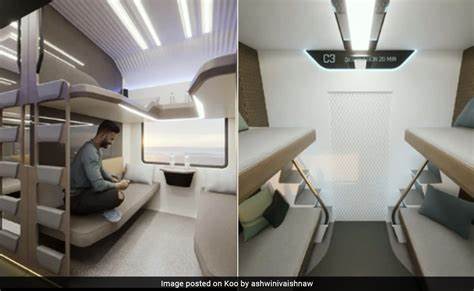Finance Minister Nirmala Sitharaman is set to announce a significant enhancement to India’s railway infrastructure as part of the Railway Budget 2024. The introduction of the Vande Bharat sleeper train and Vande Metro marks a strategic move towards modernizing and expanding the country’s rail transport network.
The Vande Bharat sleeper train is poised to revolutionize long-distance travel across India, offering enhanced comfort and efficiency for overnight journeys. Designed to replace traditional sleeper class trains, this new model will feature state-of-the-art amenities and a focus on passenger comfort. The initiative aligns with the government’s broader vision of providing a more comfortable and reliable travel experience for commuters on extensive routes.
The Vande Metro, on the other hand, is targeted at improving short-distance travel within urban and peri-urban areas. This service aims to address the growing need for efficient transportation in densely populated regions. With frequent stops and streamlined operations, the Vande Metro will cater to daily commuters and offer a more convenient alternative to existing local train services.
These announcements are part of a broader strategy to upgrade India’s railway system, which has been a priority for the current administration. The emphasis on new technologies and improved passenger services reflects a commitment to boosting the efficiency and reach of the railway network. This approach not only promises to enhance the travel experience but also supports the government’s broader infrastructure goals.
The introduction of these trains comes as part of a larger initiative to revitalize the Indian Railways, which has historically been a crucial component of the country’s transportation infrastructure. By focusing on both long-distance and short-distance travel solutions, the new services are expected to meet the diverse needs of the Indian public, from cross-country journeys to daily commutes.
The Railway Budget 2024 will likely detail the timelines for the rollout of these new trains, including the expected launch dates and the regions that will initially benefit from these services. As the rollout progresses, the impact on travel patterns and passenger satisfaction will be closely monitored.
This investment in railway infrastructure is anticipated to bolster economic growth by enhancing connectivity between regions and improving logistical efficiency. The new trains are expected to be equipped with advanced safety features and energy-efficient technologies, aligning with broader environmental goals and contributing to sustainable transportation practices.
With these developments, the Indian government is reaffirming its commitment to modernizing public transport and improving overall travel experiences. The introduction of the Vande Bharat sleeper train and Vande Metro represents a significant leap forward in the evolution of the country’s railway network, setting the stage for continued advancements in the sector.




 CRR Cut To Help Banks Facing Low Deposit Growth: SBI MD
CRR Cut To Help Banks Facing Low Deposit Growth: SBI MD 